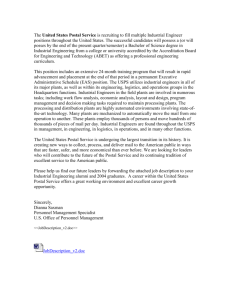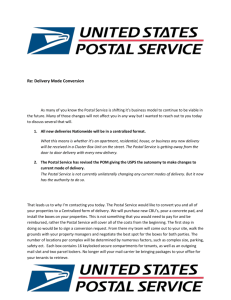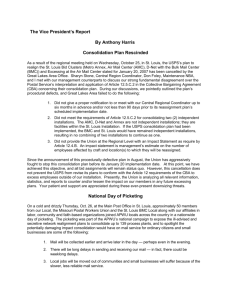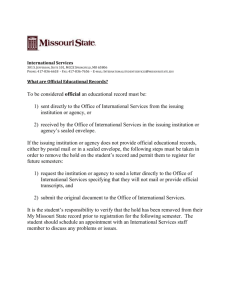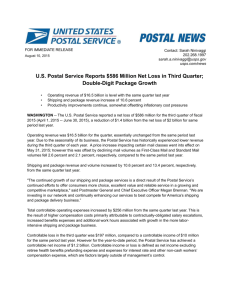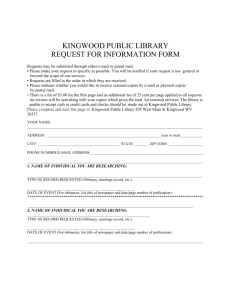Five-Year Business Plan
advertisement
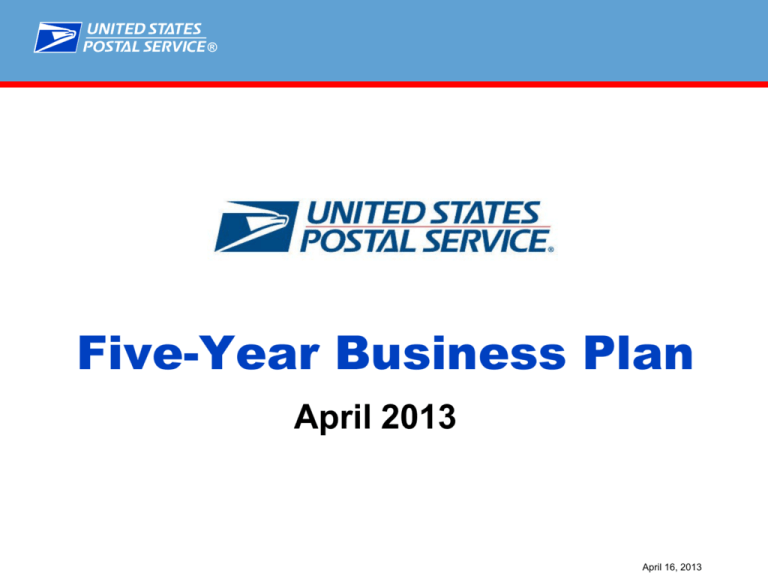
®
Five-Year Business Plan
April 2013
April 16, 2013
Business Environment
This U.S. Postal Service (USPS) business plan (“Business Plan”) is designed to
communicate to key stakeholders the vital role that the USPS plays in the U.S. economy
and important solutions required to return the Postal Service to financial and operational
viability and self-sufficiency. Specifically, the document covers
•
•
•
•
•
Challenges facing the organization today
Actions USPS is planning to take to address its financial position and outlook
Financial benefits of the identified initiatives and impact on USPS stakeholders
Overview of continuing actions to confront revenue declines through innovation
Legislation required to remove restrictions on our ability to address changes in the business
environment
• Business Plan risks and sensitivities
Despite operational improvements which have generated significant cost savings, the
financial position of the organization has become untenable
The USPS continues to endure the negative effects of electronic diversion combined with a
weak economy and excessive funding obligations
While the USPS has appealed to lawmakers for help with the required changes to the
business model, very limited action has been forthcoming
• Complex web of stakeholders with competing interests
• Congress must balance the interests of all stakeholders and all must contribute to achieve a solution
The organization's current financial position requires urgent action to ensure the near-term
continuation of communication and delivery via the Postal Service, as well as long-term
self-sufficiency
April 16, 2013
1
Continuous Efficiency Improvements Have
Helped Mitigate Effects of Business Threats
$15 Billion of Annualized Savings in the past
six fiscal years with workhours reduced 23%
U.S. Postal Service ranked as the
1,500
1,423
most efficient postal service within the
world's top 20 largest economies(1)
1,373
1,400
$13.7
$14
$12
1,300
$9.3
$10
1,258
$8
1,183
1,200
1,149
$6
1,122
Delivers ~40% of world's mail
$4
$3.2
1,100
$2
$1.2
(1)
800
1,000
Oxford Strategic Consulting report issued December 15, 2011
696
685
2008
2009
2010
2011
2012
30.0
663
Total Factor Productivity
557
528
500
400
300
200
'08
'09
'10
23.8
25.0
'11
'12
TFP Cumulative Trend
584
600
'07
2007
Postal Service is More Efficient Than Ever
623
'06
$0
2006
Career Employees – Reduced by 168,000 (24%)
during last six fiscal years, without layoffs
700
$16
$12.3
Total Workhours
(Millions)
industry in the U.S. that employs
approximately 8 million people
$14.8
($ Billions)
The core of an $800 billion mailing
$18
1,459
20.0
15.0
10.0
5.0
0.0
-5.0
1972
1980
1990
2000
April 16, 2013
2012
2
USPS Financial Position has Deteriorated
in Recent Years
Mail Volume Decline: 25% from 2007 to 2012
Revenue Down $10B (13%) from '07 to '12
250.0
80.0
203
Pieces in billions
200.0
$75.0
$75.0
70.0
177
171
168
$68.1
$67.1
2009
2010
$65.7
$65.2
2011
2012
60.0
160
150.0
$ billions
212
100.0
50.0
40.0
30.0
20.0
50.0
10.0
0.0
0.0
2007
2008
2009
2010
2011
2007
2012
$41B of Net Losses
Borrowing Reserves Fully Used
$0.0
$20
($2.0)
($6.0)
($2.8)
($3.8)
($5.1)
$ billions
$ billions
($4.0)
($5.1)
($8.0)
($10 .0)
2008
$15
In FY2012, the
USPS reached its
$15 billion statutory
debt limit.
Total Debt: FY07 – FY12
15.0
12.0
13.0
10.2
$10
($8.5)
7.2
($12 .0)
($14 .0)
$5
4.2
($16 .0)
($15.9)
($18 .0)
2007
2008
2009
2010
2011
2012
$0
FY 07
FY 08
FY 09
FY 10
FY 11
FY 12
Dire financial position requires urgent action to ensure continued mail delivery and to restore long-term self sufficiency.
April 16, 2013
3
Profit Margins Decreasing
Driven by Loss of First-Class Mail
$ Billions
30.0
$28.0
0.2
0.3
1.6
0.1
0.5
1.6
25.0
7.6
FY07 – FY12
$28.6
7.4
$25.0
$24.8
0.5
0.1
0.8
1.4
5.4
20.0
1.6
5.7
$24.0
$23.7
0.2
0.8
0.8
1.5
2.1
5.9
5.5
Packages:
Gain of
$0.5B
('07 vs. '12)
15.0
10.0
18.3
19.0
17.7
16.7
15.7
15.3
FY2010
FY2011
FY2012
International
Periodicals & Other
5.0
First-Class:
Loss of
$3.0B
('07 vs. '12)
0.0
FY2007
First-Class
FY2008
Standard
FY2009
Shipping & Packages
Profit Margin equals revenue less direct labor and non-personnel costs. It does not include institutional / fixed costs.
April 16, 2013
4
Many Factors Contribute to
Continuing Financial Problems
Volume
Mail volume declining due to
electronic diversion
Advertising mail is subject to
more substitution options
Mail volume highly sensitive
to economic changes
Packages are growing – but
much lower profit margins
Scope of products / services
limited by law
Price
Declining
steadily
Fixed cost
base
Universal Service
Obligation
Consistent pricing and
These trends will continue
to put pressure on USPS's
ability to provide affordable
universal service
service for all 50 states
plus territories
Postal network costs
driven by:
• Delivery points
• Retail locations
• Sortation facilities
• Delivery days & timing
Labor Costs
Capped by inflation
~80% of total costs
Price elasticities are in
COLA increases
flux due to growing
alternatives
Federal benefits are
48% of total labor costs
Limited flexibility
Rising but
capped
Rising cost
per hour
April 16, 2013
5
Current Financial Situation - Critical
25% decline in mail volume has reduced annual revenue by ~$10
billion since 2007, despite regular price increases, as permitted by law.
The greatest revenue loss ($7.8 billion) is in our most profitable
product – First-Class Mail, which has a 53% profit margin.
Over $41 billion of cumulative net losses in the last six fiscal years
(2007-2012), since the enactment of the Postal Accountability and
Enhancement Act.
Huge losses are after the effects of productivity improvements. Work
hour savings have removed over $50 billion of cumulative costs over
the same six-year period.
Borrowing has increased by $11 billion, to the $15 billion limit, since
2007, due to RHB prefunding payments ($21 billion) and operating
losses.
Forced to default on $11.1 billion of RHB pre-funding payments due in
2012.
This negative financial picture has created a “crisis of confidence” for
the Postal Service in the eyes of the market place.
April 16, 2013
6
USPS is Incurring Unsustainable Losses
that will Worsen without Urgent Actions
USPS's financial losses are at unsustainable levels
Declines in revenue are being driven by lower First-Class Mail volumes (down
28% since 2007)
Reduced volumes are, in turn, reducing density and profit margin across the
USPS network
Historical and Projected Net Profit ($ in billions)
$5.0
$0.0
($5.0)
$3.3
$2.8
($8.4)
($5.6)
($2.8)
($5.1)
Before the effects of Strategic Initiatives
($2.4)
($1.4)
($4.0)
($7.8)
($10.0)
($3.0)
(1)
($5.1)
($4.8)
($5.0)
($7.0)
($9.2)
($5.5)
($8.5)
($5.5)
($16.6)
($5.6)
($11.1)
($10.6)
($15.0)
(2)
($11.3)
($10.6)
($5.7)
($12.7)
($15.9)
($5.7)
($14.9)
($20.0)
($5.8)
($17.1)
($16.6)
2016
2017
($25.0)
2007
2008
2009
2010
2011
Net Profit / (Loss) Before RHB Pre-Funding
2012
2013
Impact of RHB Pre-Funding
2014
2015
Deferred RHB
Note: Bolded figures after 2007 represent Net Profit / (Loss) after RHB Pre-Funding
(1) In 2009, $4.0bn of RHB Pre-Funding was deferred and will be re-evaluated in 2017
(2) In September 2011, Congress rescheduled the 2011 required RHB payment of $5.5bn until August 2012. The Postal Service defaulted on the 2012 payment and
anticipates that future defaults will occur, absent legislative change to the RHB prefunding obligation.
April 16, 2013
7
Expenses Exceed Revenue
and the Gap is Growing
Expense
$ in Billions
Baseline Expense
Outlook before any
Initiatives
Historical expenses
(peaks and valleys
driven by rescheduling
of RHB pre-funding)
$90
$85
$75
RHB Pre-Funding
ends
Net Losses
$70
$20 B Gap
$80
$65
$60
Revenue
$55
Revenue
$50
$45
2006
2007
Debt (1)
Debt (2)
$4
$4
2008
$7
$7
2009
$10
$10
2010
$12
$12
2011
$13
$13
2012
$15
$15
2013
2014
2015
2016
2017
2018
2019
2020
$18
$33
$25
$45
$31
$57
$37
$70
$48
$82
$61
$95
$77
$111
$93
$127
(1) Assumes no USPS initiatives and no RHB prefunding paid in 2012 – 2017 ($34B).
(2) Assumes no USPS initiatives but with RHB prefunding paid 2012 – 2017 ($34B).
April 16, 2013
8
Restructuring Objectives
USPS's Business Plan continues to be based upon key
restructuring objectives that benefit stakeholders:
Preserve the ability to provide and finance secure, reliable and affordable universal
delivery service
Further economic growth and enhance commerce
Implement comprehensive transformation for a long-term sustainable financial future
Protect U.S. taxpayers (avoid Federal funding and appropriations)
Maintain fairness to employees and customers
April 16, 2013
9
First-Class Mail Declines Will Continue
Shipping & Packages Will Grow
First-Class Decline: $6.2B from 2012 to 2017
Flat Revenue from 2012 to 2017
80.0
Total Revenue
30.0
70.0
40.0
30.0
$65.2
$64.9
$64.8
$64.6
$64.9
$64.6
$ Billions
50.0
25.0
$28.9
$27.6
20.0
$26.3
$25.0
$24.0
20.0
$22.7
10.0
15.0
2012
0.0
2012
2013
2014
2015
2016
2013
2014
2015
2016
2017
2017
Shipping / Packages Increase: $4.8B from 2012 to 2017
Flat total revenue over next 5 years, net of volume
declines and price changes.
Loss of another $6 billion of First-Class revenue –
results in loss of $3 billion of profit margin (at 53%)
in 2017.
Gain of $5 billion of Shipping/Package revenue provides
$0.9 billion of profit margin (at 18%) in 2017.
Decrease in profit margin in 2017 from these two major
items results in loss of $2 billion in annual profitability.
20.0
$ Billions
$ Billions
60.0
15.0
$13.6
$14.5
$15.4
$12.8
2013
2014
2015
2016
10.0
$11.6
$16.4
Volume/revenue changes in other mail classes have an
insignificant effect on total profit margin.
5.0
2012
April 16, 2013
2017
10
Shipping & Packages Profit Margin
1/3 of First-Class Mail in 2012
30.0
$28.9
Revenue
Contribution, or profit margin, differs by mail class.
First-Class letters have a profit margin of 53%, and
generated 64% of gross profit in 2012.
Declines in highly profitable First-Class mail have
contributed greatly to weakening financials.
Projected volume and revenue increases for
Shipping and Packages show great promise. But
the current contributions/margins for this product
of 18% cannot replace the First-Class profits lost
at 53%.
It takes ~$3 in Package revenue to make up the
profitability of every dollar lost in First-Class Mail
revenue.
To cover the $6B decline in First-Class revenue by
2017, Shipping & Package revenue would need to
grow by $18B.
25.0
$ in Billions
20.0
15.3
Profit
Margin
15.0
$16.4
5.5
2.1
10.0
13.6
5.0
$11.6
10.9
Attributable
Cost
9.5
$2.8
0.8
2.0
0.0
First-Class Mail
Standard Mail
Shipping & Packages
Cost
-5.0
International
$1.7
2.4
-0.7
Periodicals
$2.7
0.7
2.0
Other
Profit Margin
April 16, 2013
11
Cost Reductions & Legislative Action Needed
for USPS to Regain Financial Self-Sufficiency
Loss of Contribution from First-Class Mail is Driving Continuing
Trend of Operating Losses
Growth in Shipping and Packages is not sufficient to replace First-Class
Mail profits
53% contribution from First-Class Mail revenue cannot be replaced with
18% contribution from Shipping & Packages revenue
To remain viable, the Postal Service must continue to cut costs and
improve efficiency
Labor costs represent 79% of the Postal Service total cost base
49% of labor costs are devoted to delivery
48% of labor costs are devoted to benefits
18% of total cost base is devoted to Health Care
Legislative action is also required to give Postal Service authority to
generate new revenue and adapt to changing business conditions
Scope of products and services limited by law
Cost of federal benefits programs for health care, retirement and other
benefits
Reform governance model
April 16, 2013
12
Benefits Costs Contribute to
High Personnel Costs
Baseline* FY2012 Total Costs: $75.6B
Of which $13.4B (18%) is Healthcare
Personnel
$59.6 B
(79%)
Non-Personnel
$16.0B
(21%)
Wages for
Hours Worked
$30.8B
(52%)
Benefits
$17.9B
(30%)
Paid
Time Off
$5.3B
RHB
(9%) Pre-funding
$5.6B
(9%)
Paid Time Off, Benefits & RHB:
•FERS Contributions
$3.0B
1.0
•Thrift Saving Plan
1.9
•Social Security
5.2
•Health Insurance & Medicare
•RHB Premiums (Current Retirees) 2.6
5.6
•RHB Prefunding
5.3
•Paid Time Off
•Workers' Comp
3.7
0.5
•Other
Total
$28.8B
$13.4B
* Includes only the expense of the FY2012 RHB pre-funding ($5.6B) and not the second RHB
pre-funding carried-over from FY2011.
April 16, 2013
13
Cost Structure – By Employee Activity
(1)
FY2012 Employee Wages & Direct Benefits
Postmasters /
Installation Heads
$2.6B
5%
= $47.7B
Vehicle Services
$1.2B
3%
Building Services
$3.1B
7%
SG&A
$2.8B
6%
Mail Processing
$8.8B
18%
Career Employees (Sept 2012):
NALC:
City Delivery
NRLCA: Rural Delivery
NPMHU: Mail Processing
APWU: Multiple Functions
Postmasters & Installation Heads
All Other Employees
TOTAL
Career Employees
(March 2013)
498K
Rural Delivery
$6.2B
13%
Customer
Services
$6.0B
12%
City Delivery
$17.1B
36%
(1) Direct Benefits include
FERS Contributions,
TSP, Social Security, Health
and Others.
177K
67K
42K
186K
17K
39K
528K
49 Percent of
Personnel costs
directly attributable
to Delivery.
$ in billions
April 16, 2013
14
Executing on Identified Initiatives is Core to
Addressing USPS's Financial Challenges
USPS needs to save up to $20 billion annually over the next five years, of which nearly
half requires legislative action
Each of the Strategic Initiatives is essential in order to restore the Postal Service to
financial viability
Key Items for Consideration
USPS-sponsored health insurance is significantly more cost effective and yields equivalent or better
coverage for the vast majority of annuitants and current employees
Healthcare
Reduced
Network
Density
from Volume
Declines
The Postal Service projects approximately $8 billion of annual savings from the adoption of a new USPSadministered healthcare program (including elimination of prefunding and transfer of retirees into USPS
Plan)
RHB Pre-Funding elimination of ~$5.7bn annually plus reduced healthcare costs of ~$2bn annually
Network costs are fixed and too high relative to mail volumes and reduced density
USPS needs flexibility as well as cost reduction
Better align network size with volumes
Mail processing facilities are being streamlined and consolidated
Reducing the cost to serve in our retail network to align with customer evolving needs and provide
expanded access to our products and services
Service levels must be addressed
6 day package delivery and 5 day mail delivery
Modify overnight service standard for First-Class Mail as part of network optimization
Expand centralization of delivery points
Revenue
Management
Expand scope of products and services allowable
Enhance Mail experience: Digital connections to websites, social media, purchase points
Targeted price changes:
Re-price for volume
Re-price to eliminate contribution losses on certain products
Package Growth: Take advantage of carrier network
Investments in advertising and infrastructure
Governance
Governors must have authority commensurate with responsibility
April 16, 2013
15
Summary of Cost Initiatives in the
Five-Year Business Plan
USPS has worked extensively to develop a targeted cost reduction program for the elimination of
$20+ billion of annual cost from the business within the next five years
Description
Healthcare
Workforce and NonPersonnel
~$5.7bn from elimination of
RHB Pre-Funding
$2bn from Postal Health Plan
for retirees and employees
$6B refund of
overfunding
$0.3bn annually
Rationalize service standards
Consolidation of mail processing
facilities
Relocation of equipment
Capture of reduced volume workload
$120mm Opex
$265mm Capex
$2.4 bn in 2014, growing to
$3.4bn in 2017
Includes workload
Reducing cost of service
Simplifying product offering to
enhance customer experience
Optimizing levels of services based
on customer demand
Capture of reduced volume workload
Delivery Optimization
Expand business and residential
delivery to centralized boxes
Capture of reduced volume workload
Packages – 6 day delivery
Mail – 5 day delivery
Reduction in total unit labor costs
Non-Personnel savings
Retirement plan of the future
6 Day Packages
5 Day Mail
Delivery
Accounting
methodology & noncash adjustments TBD
Reduction in FERS obligation and
“normal cost” contribution, based on
USPS-specific assumptions &
demographics
Retail
Savings
FERS
Network
Health benefits plan sponsored by the
Postal Service
Initial Costs / Benefits
$40mm Capex
$35mm Opex
$45mm Capex
$200mm Capex
$100mm Opex
$1.2bn in 2014, growing to
$1.6bn in 2017
Includes workload
$1.0bn in 2014, growing to
$1.8bn in 2017
Includes workload
$1.9bn annually, when fully
implemented
Workforce $1.8bn in 2017
Non-Personnel growing to
$2.5bn in 2017
April 16, 2013
16
Savings by Strategic Initiatives
$ in Billions
Savings
by Strategic Initiative ($ Billions)
Strategic Initiatives ($ Billions)
25.0
2016
Savings
Operational Initiatives
Networks
Retail
Delivery
Total Operational Initiatives
$13.5
$17.6
20.0
$
3.1
1.5
1.4
2.6
0.4
2.3
15.0
6.0
Workforce & Non-Personnel
1.9
8.6
0.6
11.1
$
19.7
0.3
6.2
10.0
(1)
5.7
5.7
1.8
5.6
Legislative Initiatives
5-Day Mail Del. + Saturday Pkgs
Postal Health Plan
FERS & Other
Total Legislative Initiatives
Total 2016 Savings
$15.2
5.0
-
0.7
0.7
0.9
1.1
2013
$19.7
$17.2
0.6
2.8
0.7
3.5
5.8
4.3
2.6
1.9
1.6
1.3
1.0
1.2
1.9
1.1
1.5
1.9
1.4
1.5
2.4
2.9
3.1
3.4
2015
2016
2017
2014
Networks
Retail
Delivery Routes & Mode
5-Day Delivery
Workforce & Non-Personnel
RHB pre funding.
Postal Health Plan
FERS & Other
1.8
1.6
(1) Includes $6B estimated refund of FERS overfunding.
April 16, 2013
17
$ in Billions
Savings - Operational Initiatives
Operational Initiatives & Workload
Networks (Consolidations in '13 - '14)
Retail (Post Plan + Workload)
Delivery Optimization
Operational Initiatives & Workload Total
2012A
2013
2014
2015
2016
0.3
0.4
0.4
1.1
0.9
0.7
2.4
1.2
1.0
2.9
1.5
1.1
3.1
1.5
1.4
2017 '13 - '17
3.4
1.6
1.8
12.9
6.7
6.0
1.1
2.7
4.6
5.5
6.0
6.8
25.6
A= Actual
Networks
•
•
•
Retail
•
•
Delivery
•
•
•
•
In Summer 2012, adopted two-phase approach to approx. 200 mail processing consolidations. Phase I in Summer
2012 to Spring 2013. Phase 2 in Spring 2014.
In 2012 and 2013, approximately 22,500 employees represented by the APWU and 2,925 Mailhandlers accepted
incentives to retire or resign.
In 2013, Plan was revised to accelerate portions of Phase 2 Consolidations to June-Sept ’13, without impacting service
standard.
PostPlan reduces hours in 13,000 Post Offices (2-4-6 hrs/day) in 2013 and 2014. Replaces Postmasters in small
offices with non-career employees.
4,275 Postmasters accepted buy-outs in Aug 2012. Remaining savings begin in 2014 when 2-year saved Postmaster
pay expires.
Self-Service Expansion – Deployed 264 self-service kiosks to 132 Post Offices in 5 markets.
Transaction shift to alternate access to create a decrease in Post Office workload
Delivery Unit Optimization plan consolidates 1,500 delivery (non-retail) offices by 2015.
Expand centralized delivery for both business and residential deliveries.
April 16, 2013
18
Strategic Initiative: Network Consolidations
From 417 Processing Facilities
Consolidate Excess Capacity
417 processing facility network built to
handle 250 billion pieces of mail
Current and projected volumes call for
network of <250 facilities
2012 Plan assumed all consolidations &
service standard changes in 2012.
In Summer 2012, adopted two-phase
approach in order to allow Congress
sufficient time to pass comprehensive
Postal Reform legislation.
Phase I - Summer 2012 - Spring
2013.
Phase 2 - Spring 2014.
Rationalized Network of <250 Facilities
Accelerating portions of Phase 2
Consolidations to June-Sept '13 without
impacting service standard.
$3.4 billion savings achieved in 2017,
including workload effects.
April 16, 2013
19
Strategic Initiatives: Retail
Retail Channel Strategies
• Transform customer experience in
high traffic Post Offices by increasing
the availability of self service
• Enhance customer experience
through expanded retail partnerships
• Preserve retail service in rural
America by modifying window service
hours to match the local customer
demand and establishing Village Post
Offices with local businesses to
provide postal services where
customers shop
2017 Savings ($ in billions)
Workload Impact of Reduced Volumes
$
PostPlan
Total Retail Savings
1.0
0.6
$
1.6
Savings Detail
Volume decline of 21 billion pieces by 2017 reduces
retail workload
• Increase adoption of self service at high traffic
offices from 28% to 65%
• Shifting transactions to alternative access
• Increase alternate access retail revenue from
40% to 60%
• Implement non-career staffing at 13,000 small
Post Offices (level 16 and below)
• Phase in 2-4-6 hour operations throughout 2013
and 2014
April 16, 2013
20
Strategic Initiatives: Delivery
2017 Savings ($ Billions)
Expand
Centralized Delivery
Savings of $65 per year for each delivery
converted from curb to central
Savings of $190 per year for each delivery
converted from door to central
Savings will more than cover the costs
associated with centralized delivery boxes:
● Purchase cost
● Installation cost
● Maintenance cost
New delivery points - centralized
Workload Impact of Reduced Volumes
Delivery Optimization
Total Delivery Savings
$
$
0.8
1.0
1.8
Savings Detail
Workload Reduction
● Volume decline of 21 billion pieces by 2017
● Delivery workload reduction by 2017 of
$0.8 billion
Delivery Optimization Savings:
● Delivery Unit Optimization (consolidations)
– approx. 1,500 planned by 2015
● Route Optimizations continue
April 16, 2013
21
Savings - Workforce and
Non-Personnel Initiatives
$ in Billions
Workforce & Non-Personnel Initiatives
Wage Restraint + Flexibility (3 unions)
Interest Savings
Workforce & Non-Personnel Total
2012A
0.3
-
0.3
2013
2014
2015
2016
0.7
-
1.5
0.1
1.7
0.1
1.8
0.8
2017 '13 - '17
1.8
2.5
7.5
3.5
0.7
1.6
1.8
2.6
4.3
11.0
A= Actual
Wage Restraint +
Flexibility
•
•
•
•
•
•
Interest Savings
•
•
Arbitrations with remaining 3 major unions completed in 2013 (City and Rural
Carriers and Mail Handlers).
Arbitrated contracts follow similar pattern to the 2011 APWU contract, with
two year pay and COLA freezes (back-dated to end of last contract), followed
by modest general pay increases and resumption of COLAs.
Pay increases and COLA for APWU and NRLCA begin in 2013. Pay
increases and COLA for NALC and NPMHU begin in 2014.
Savings associated with standards changes included in NRLCA contract are
still being evaluated and thus are not included above.
Contracts with NALC and MH include provisions increasing the proportion of
non-career employees to approx. 20%.
Contracts for APWU and NRLCA expire in 2015. Contracts with NALC and
NPMHU expire in 2016.
Freezes on non-bargaining pay increases have been in effect since Jan 2011.
Higher interest savings in 2016 and 2017 due to higher projected interest
rates and growing debt (up to $82 billion in 2017) in the base case.
April 16, 2013
22
Savings - Legislative Initiatives
$ in Billions
Legislative Initiatives
5-Day Mail Delivery + Saturday Pkgs (Jan 2014)
Resolve RHB prefunding (Postal Health Plan Beginning 2015)
Postal Health Plan - Actives' Premium Reductions
Postal Health Plan - RHB: Normal Cost vs Retiree Premiums
FERS Surplus Refunded
FERS - Reduce Biweekly Contribution Percentage
New Career Employee - Defined Contribution Pension Only
Workers' Compensation Reform (Equivalent to S. 1789)
Non-Postal Products and Services
Legislative Initiatives Total
2012A
2013
2014
2015
2016
-
5.6
6.0
0.2
11.8
1.3
5.7
0.3
7.3
1.9
5.7
0.2
2.1
0.3
0.1
10.3
1.9
5.8
0.4
2.4
0.3
0.1
0.1
0.1
11.1
2017 '13 - '17
1.9
0.4
3.1
0.3
0.1
0.1
0.2
6.1
7.0
22.8
1.0
7.6
6.0
1.4
0.2
0.2
0.4
46.6
A= Actual
Delivery Schedule
RHB Prefunding
• 6-day package delivery and 5-day mail delivery begins in Jan 2014.
• Reduced workload from 5-day mail delivery. Noncareer flexibility used for Saturday packages
• Requesting Congress to require Postal Health Plan for both active employees and retirees beginning
January 2015.
Postal Health Plan
(Active Employees)
Postal Health Plan
(Retirees)
• Eliminates need for prefunding in 2013 and beyond.
• Requires union agreement under current law.
• Requesting Congress to require Postal Health Plan, beginning January 2015.
• Market Postal Health Plan to retirees while continuing to pay FEHBP premiums (pay-as-you-go) through
•
•
FERS Refund &
Biweekly Contribution
Percentages
New Career Employee
Workers’ Comp Reform
Non-Postal Products &
Services
•
•
•
•
•
2014.
Requesting Congress to require Postal Health Plan for retirees, beginning January 2015.
Postal Health Plan will reduce costs, providing for a fully funded RHB, therefore only paying annual
“normal cost” in 2015 and beyond.
Estimated values using Postal-specific assumptions (primarily pay increases and demographics), versus
the government-wide assumptions currently used by OPM.
Savings from changing from defined benefit pension to defined contribution plan (TSP) for employees
hired beginning in 2015.
Savings don’t begin until 2016 because of minimal number of new hires.
Assumes enactment of reforms from Senate Bill passed in April 2012.
Includes estimated financial benefit of shipping beer and wine and providing services on behalf of federal
and local government agencies.
April 16, 2013
23
Strategic Initiative:
6-Day Package Delivery / 5-Day Mail Delivery
Public Support for Five Day Mail
80
Saturday Package Delivery
% Favorable
60
50
67
70
New York
Times/CBS
News
71
30
USA Today
40
68
20
10
Gallup
0
Washington
Post
Continue Saturday package
delivery, which is a competitive
advantage
● Supports on-line purchases
● Continues 6-day delivery of
commercial packages, such
as prescription medicines
Eliminates mail delivery on
Saturday, which is generally the
lowest volume day
● Many businesses are closed
Saturdays
Does not affect service to PO
Boxes
Post Offices with Saturday hours
will remain open
~$2 billion annual savings
Supports Package Growth
3.5
3.3
Volume (billions)
70
3.1
2010
2011
2012
April 16, 2013
24
USPS Health Plan
Generates Significant Savings
Current Position
Postal Service does not control its
health care benefit program
Current federal programs exceed the
private sector comparability standard
in terms of cost and coverage
Postal Health Plan
Three distinct categories of participants –
annuitants, current employees and new
hires
Tiered program appropriate to the
varying coverage needs of participants
Current programs do not align benefit
value with cost or reflect USPS
demographics
Adopt best practices in private sector –
pharmacy benefit management, wellness
incentives, etc.
Retiree Health Benefit obligation of
$94B, of which $46B (49%) was
funded (as of Sept 2012)
Maintain benefit choices with consistent
alignment between value and cost
Simplify plan structure and self insure
Establish incentives for Medicare-eligible
retirees to fully participate in Medicare
benefits
Result: ~$8B of annual cost savings
through 2016
April 16, 2013
25
Key Legislative Goals
To Regain Financial Self-Sufficiency
Require USPS Health Care Plan
Resolves RHB Prefunding Issue
Refund FERS Overpayment
Adjust Delivery Frequency (6-Day Packages, 5-Day Mail)
Streamline Governance Model
Authority to Expand Products and Services
Require Defined Contribution System for Future Postal
Employees
Instructions to Arbitrator
Reform Workers' Compensation
Right to Appeal EEOC Class Action Decisions
April 16, 2013
26
2013 Business Plan Financial Projections
($ in billions)
Projected
2012A
Total Revenue
(1)
Operating Expenses (Before Initiatives)
Operating Income (Before Initiatives) (1)
RHB Pre-Funding
(1)
Operational Initiatives
Workforce + Non-Personnel Initiatives (2)
Legislative Initiatives
Total Contribution from Strategic Initiatives
Restructuring/Separation Costs
Revised Operating Expenses
Capital Outlays
Net (Debt) / Cash
(1)
(1)
2014
2015
2016
2017
$ 65.2 $ 64.9 $ 64.8 $ 64.6 $ 64.9 $ 64.6
68.9
69.9
71.8
73.8
76.2
81.2
(3.7)
(5.0)
(7.0)
(9.2)
(11.3)
(16.6)
(14.8)
(5.6)
(10.6)
(5.7)
(12.7)
(5.7)
(14.9)
(5.8)
(17.1)
(16.6)
1.1
0.3
1.4
(0.1)
2.7
0.7
11.8
15.2
(0.3)
4.6
1.6
7.3
13.5
(0.5)
5.5
1.8
10.3
17.6
-
6.0
2.6
11.1
19.7
-
6.8
4.3
6.1
17.2
-
78.7
60.6
64.5
61.9
62.3
64.0
$ (13.5) $
4.3
(11.1)
Net Income/(Loss) (Before Initiatives)
Updated Net Income / (Loss)
2013
$
0.3
$
2.7
$
2.6
$
0.6
$
(0.8) $
(1.5) $
(2.1) $
(2.1) $
(1.9)
$ (12.9) $
(7.4) $
(6.7) $
(4.2) $
(1.4) $
(0.5)
A= Actual
(1) Excludes non-cash adjustments to workers' compensation.
(2) Effect of contract negotiations, workforce flexibility, non-personnel initiatives and interest.
April 16, 2013
27
Strategic Initiatives will Reduce Workload
and Staffing Needs
The Postal Service anticipates a reduction of ~146K Career and
Non-Career Full-Time-Equivalent Employees (FTE's) by 2017
700
Strategic Initiative Impact
633
FTE / Career Headcount (thousands)
FTE's
(11)
(14)
Workload Impact
608
600
(10)
(57)
FTE
Career Employee Reductions
541
(8)
(11)
522
528
(2)
(16)
504
500
485
432
417
400
2013
(10)
487
FTE's
444
2012
(7)
2014
2015
2016
404
2017
April 16, 2013
28
Financial Projections after
Strategic Initiatives Achieved
Achieving the Business Plan will produce reasonable profits that will allow for debt repayment.
This requires full realization of all the Strategic Initiatives.
Net Profit (1) ($ in billions)
Net Debt ($ in billions) eliminated
10
10
Without initiative impacts2017 Debt of $82B
$2.7
Cash
$4.3
5
$2.6
5
$0.6
$0.3
0
0
-$0.5
(5)
-$1.4
(5)
Without initiative impactsAverage annual net losses (1) of $14B
-$4.2
Debt
(10)
-$7.4
-$6.7
(10)
(15)
-$15.9
-$12.9
(20)
0
(1)
2012
2013
2014
2015
2016
2017
(15)
2012
2013
2014
2015
2016
2017
Excludes impacts of non-cash adjustments (if any) to workers' compensation liability in 2013 - 2017.
April 16, 2013
29
Revenue Growth Initiatives
Will Accompany Cost & Efficiency Improvements
Enhance Mail - Create a multi-sensory experience
Mobile on mail that interacts with consumers
Mail with Audio/Visual features
Hardcopy to digital that connects consumers to:
Website
Social media or
Purchase point
Package Growth
Close competitive gaps to level the playing field:
Competitive pricing
New Priority Mail Features: Day-Certain and Insurance
Build advantages by targeting new solution for ecommerce
Speedier service
Improved access that enables customers and consumers to
use USPS services easier and more effectively.
Digital Products - extend the USPS's current technology and data
platform in ways that help better support the mailing industry and
the American public
April 16, 2013
30
Revenue & Volume Forecasts
Volume Forecasts
Revenue Forecasts
70
160
60
140
50
120
Pieces in billions
$ Billions
180
40
30
20
100
80
60
40
10
20
0
0
2012 2013 2014 2015 2016 2017
First-Class
Periodicals
International
Standard
Shipping & Packages
Other
2012 2013 2014 2015 2016 2017
First-Class
Standard
Periodicals
Shipping & Packages
International
Other
April 16, 2013
31
Analysis of Revenue & Volume Forecasts
First-Class Mail
• Projected annual volume declines of 5% - 6%
• Price increases offset some of volume loss, but revenues expected to drop 4% - 5% annually
• Revenue expected to drop to $22.7 billion (36% of total revenue) in 2017, compared to 45% in 2012
Standard Mail
• Volumes and revenues projected to remain relatively flat through 2017, as the advertising
market remains highly competitive
Shipping and Packages
• Projected volume growth between 5% - 6% per year
• Revenue growth of 6% - 7% annually
• Expected to make up $16.4 billion or 26% of 2017 total revenue, compared to 18% in 2012
Periodicals
• Volumes and revenue continue to slowly decline consistent with historical and societal trends
International
• Revenues are projected to grow modestly on slightly decreasing volume
April 16, 2013
32
Sensitivity Analysis / Risks
Legislative reform must be enacted
Require Postal Health Plan for employees and retirees
Without legislative reform, debt would need to climb to
$58 billion in 2017
Risk of less-than-optimal legislation
Economic risk – further economic slowdown or recession could
worsen electronic diversion of First-Class Mail and slow growth
of Standard Mail and Packages
Further delays in implementing all elements of the Plan have
cumulative financial effects
April 16, 2013
33
Losses Continue Without Legislation
Debt Continues to Grow
Assumes all Postal Service Initiatives, but does not include any legislation.
85
70
60
50
75
40
Debt
Revenue & Expense
80
30
70
20
65
10
60
0
2007
$ Billions
2008
2009
2010
2011
Net Debt
2012
2013
Revenues
2014
2015
2016
2017
Expenses
April 16, 2013
34
Forecast Sensitivity
to Mail Volume Changes
Revenue ($ in billions)
Revised Net Income (Loss) ($ in billions)
$10.0
$70.0
$68.0
$67.8
$5.0
$64.6
$-
$66.0
$64.0
$62.0
$61.4
$10bn
variability
$6bn
variability
$(5.0)
$60.0
$58.1
$58.0
$56.0
2012
2013
2014
2015
2016
2017
$(10.0)
$(15.0)
2012
2013
2014
2015
2016
2017
Net Cash (debt) ($ in billions)
Economic Sensitivity
$10.0
•
•
•
If economic conditions or electronic diversion changes
so that annual mail volume increases by 5%, then net
income and cash are positively impacted
In comparison, the 2007 – 2009 recession resulted in a
reduction of approx. 10% of revenue, which is
consistent with the purple line in each graph.
For declines in mail volume due to economic
conditions or accelerated electronic diversion, only ½
of workload effects are captured. This is due to the
aggressive Plan and continued large cost reductions.
The result is annual net losses and increasing debt.
Volume 5% Higher
USPS Plan
$$(10.0)
$38bn
variability
$(20.0)
$(30.0)
$(40.0)
2012
Volume 5% Lower
2013
2014
2015
2016
2017
Volume 10% Lower
April 16, 2013
35
All Elements of Plan Must be Implemented
to Provide for Long-Term Financial Stability
The challenges facing USPS are both economic and structural
●
Decline of high contribution First-Class Mail
●
Inflexible business model, including high-cost retirement and health benefits programs
The Postal Service's 5-Year Plan
●
Continue to generate new revenues, particularly in the Package business where our
delivery network and schedule are a competitive advantage
●
Re-structure the USPS network
●
Achieve requisite legislative changes
●
Adopt the USPS healthcare program for employees and retirees
●
Implement 6-days-per-week package delivery schedule and 5-days-per-week mail
delivery
The Plan enables the USPS and all of its stakeholders to:
●
Preserve the Postal Service's mission to provide secure, reliable and affordable
universal delivery service
●
Make the Postal Service economically self-sustaining
Successful restoration of Postal Service financial stability requires implementation of
ALL aspects of the Plan
April 16, 2013
36
